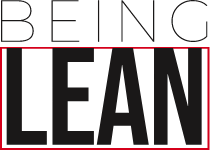Gamifying Lean: Turning Continuous Improvement into a Win, Not a Chore
Lean has taught me many things over the years, how to see waste where others see normal, how to build systems around people not just tasks, and how to keep things moving forward even when things feel stuck. But if I’m completely honest, there’s something Lean didn’t always get right for me. It didn’t always feel good.
There were times, especially in the early days of coaching others, when Lean felt more like a checklist than a change. A measuring stick. A ruler smacked on knuckles. “You’re not Lean enough.” “You’re doing it wrong.” And I’ve watched others experience the same: the heaviness, the guilt, the perfectionism that can creep into Lean when it’s taught or applied with too much discipline and not enough motivation.
That’s why, as I’ve been building Leanier, a Lean thinking app for everyday life, I’ve been obsessing over a different question: How can we make continuous improvement feel like progress, not punishment? Let’s be honest, in both work and life, if it doesn’t feel good (or at least meaningful), people will abandon it.
Progress vs. Perfection: The Real Behavioural Bottleneck
Whether I’m working with busy professionals, overwhelmed parents, or even trying to Lean-influence my own husband (35 years and counting!), one thing is universal: People want to feel like they’re moving forward. Not ticking boxes. Not being corrected. Not stuck in loops of “what didn’t you do this week?”…but genuinely progressing. Becoming Leaner. Freer. Lighter.
And yet, Lean, when presented rigidly, can unintentionally do the opposite. We aim for “perfect” flow. Perfect 5S. Perfect metrics. But perfection isn’t motivating. Progress is. That’s why I believe gamification is no gimmick - it’s the psychological bridge between intention and sustained change.
And it’s why Leanier is being built to integrate that spark of play, ownership, and challenge that keeps people engaged long after the workshops are over.
Building Leanier Taught Me: Lean Can Be Fun (If You Let It)
When I first started mapping out Leanier, I didn’t want just another productivity app. I wanted a companion that nudged people towards better decisions in real-time - a system that helped them:
Spot waste in their home or habits,
Apply Lean tools without needing to remember acronyms,
And most of all, feel rewarded for doing small things consistently.
But the real lightbulb came when I stopped trying to “teach Lean” in the traditional way and instead started designing experiences that aligned with Lean without shouting about it.
For example:
Instead of "task completed," we reward "waste eliminated."
Instead of levels, users unlock “Lean Mastery Badges” - not for doing more, but for thinking better!
We nudge behaviour using Lean logic, but never shame. No red crosses. No failure screens. Only feedback loops.
We introduce PDCA loops subtly - small review moments that help users adjust rather than judge themselves.
Because whether you're decluttering your kitchen or managing a remote team, progress comes not from being perfect, but from engaging with the process and seeing yourself improve.
Work Applications: Why Gamification Isn’t Just for Apps
Even if you’re a consultant, team leader, or CI coach who thinks gamification is for kids or Silicon Valley… I challenge you to look again.
Gamifying Lean doesn’t mean turning your factory floor into a video game. It means designing for intrinsic motivation. Here’s what that might look like:
Visual scoreboards that track real waste removed, not just tasks completed.
Improvement Bingo: A light-hearted way to spot different wastes during your Gemba walks.
Team Challenges: Which team reduces waiting time or rework the most this week?
Micro-Rewards: Recognition for a team member who ran their first PDCA without being prompted.
It’s not about gimmicks; it’s about giving people a reason to care and a way to track what matters. Because the Lean journey is hard. Change is uncomfortable. And if we don’t celebrate small wins, the journey starts to feel like a burden rather than a breakthrough.
Why I Refuse to Build Another ‘Productivity Tool’
There are plenty of apps out there that tell you what to do. There are fewer that ask you how you feel about doing it. And even fewer that help you see WHY it matters, in the broader context of your life. With Leanier, I want to build something that:
Respects how messy real life is,
Applies Lean thinking beyond spreadsheets and post-its, and
Reframes improvement as a personal journey, not a job description.
Because for me, Lean was never about saving seconds on a production line…actually YES, it is, but AS importantly, it is always about improving my quality of life. And that includes feeling proud, curious, and hopeful - not just efficient.
Final Reflection: The Best Game Is the One You Want to Keep Playing
Continuous improvement is a lifelong game. There’s no finish line, no high score, no Lean god badge you wear forever. But if we can make it feel fulfilling, empowering, and progressive, people will keep showing up…at least for Leanier, I hope they would. I want them to look forward to how lean thinking and doing can impact their lives. They’ll start to see Lean not as something they “do” at work, but something they become in life. That’s why I believe we must gamify wisely, not to entertain, but to engage. Not to distract, but to anchor. And not to manipulate, but to motivate!
Because when Lean starts to feel like progress, not punishment… …that’s when people stick with it. …that’s when they pass it on. …that’s when it becomes who they are!
Lean isn’t just about improvement - it’s about making improvement feel worth it. And if we can build that into our tools, our teams, and even ourselves, we make Lean not just sustainable… but irresistible.
If you resonate with this, drop us a comment or/and subscribe for more Lean nuggets to “spice” up your everyday life!
